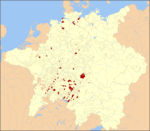Free City of Besançon

The Free City of Besançon was a self-governing free city surrounded by Franche-Comté.
After losing its status as a
History
Within the Holy Roman Empire
Besançon became part of the Holy Roman Empire in 1034 as the
When Franche-Comté passed to Philip II of Spain in 1555, Besançon remained a free imperial city.
Loss of Imperial status
The city lost its status as a free imperial city in 1651 as a reparation for other losses that the Spanish had suffered in the Thirty Years' War. After some resistance, this was finally confirmed by Besançon in 1654, although the city kept a high degree of internal autonomy.[3]
Disputes with France
In 1667
While the city was in French hands, the famed
The Spaniards built the main centre point of the city's defences, "la Citadelle", siting it on Mont St. Etiene, which closes the neck of the bend in the river that encloses the old city. In their construction, they followed Vauban's designs.
From this time onwards, a large pro-French faction grew among some of the city.
Surrender to the French
The city was to finally lose its autonomy as a result of the Franco-Dutch War starting in 1672, where the Habsburgs took the side of the Dutch and so were to lose control of Franche-Comté and Besançon. After a siege of the city, French troops occupied the city in 1674, although they agreed to allow Besançon to keep its privileges.
In 1676 the French authorities wound up the magistracy, the democratic form of government of Besançon, on the instructions of Louis XIV. A baillarge court was set up in its stead.
Institutions
Unlike most Free Imperial Cities which gradually became
The protector — first the Dukes of Burgundy and then the Austrian and Spanish Habsburgs, and for two years the King of France — had the right to appoint a president for the governors and the commander of the soldiers who guarded the ramparts. The protector was never recognised as sovereign.[3]
References
- ^ Chisholm, Hugh, ed. (1911). . Encyclopædia Britannica. Vol. 3 (11th ed.). Cambridge University Press. p. 850.
- ISBN 978-9004161733.
- ^ a b c Martin, Henri (1865). Martin's history of France: the age of Louis XIV, Volume 1. p. 295.
- ^ a b Martin, Henri (1865). Martin's history of France: the age of Louis XIV, Volume 1. p. 294.
- ISBN 9781580463034.
- ISBN 9780415128834.
- ^ ISBN 9781580463034.
+


